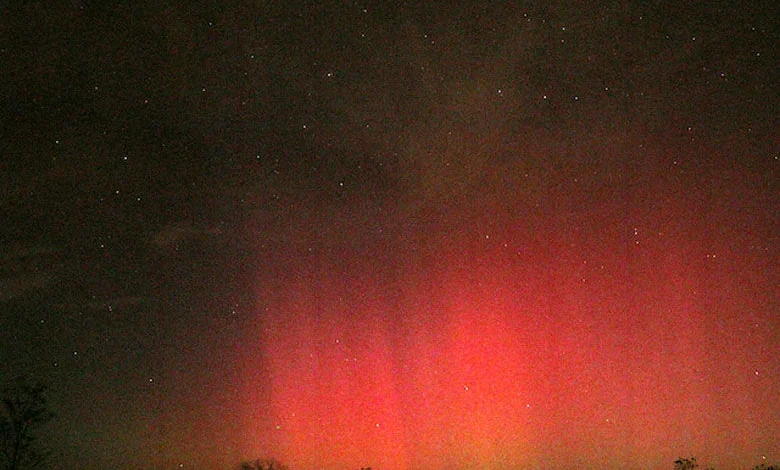Northern lights sightings possible next few nights in DC region

There’s another possibility for aurora sightings in the D.C. area beginning Tuesday night. Here’s how to possibly see the northern lights.
Tuesday is Veterans Day. My personal gratitude goes out to my fellow veterans who served our country and to those who serve today.
There’s another possibility for aurora sightings in the D.C. area this week.
For the D.C. area, the Space Weather Prediction Center‘s two-day aurora forecast and our forecast skies means there is a good chance we may detect aurora to the north.
If the prediction center’s forecast holds, aurora conditions for the D.C. region may be strong enough Tuesday night after it gets dark, into the early morning hours to allow sky watchers to detect aurora visually and with cameras.
The predicted G4 levels make aurora a real possibility for Wednesday night into the predawn hours Thursday too.
What’s happening in the skies?
To update happenings on our star since last week, a post on spaceweather.com reads, “Sunspot 4274 erupted again this morning, producing its strongest (solar) flare yet.”
This is the strongest solar flare for 2025 — an X5-class powerhouse, the highest classification.
“The flare caused a deep shortwave radio blackout over southern Africa and hurled a fast CME (coronal mass ejection) directly toward Earth,” the post reads.
According to a preliminary NASA model referenced by spaceweather.com, “the CME will reach Earth late on Nov. 12th, close behind the cannibal coronal mass ejection.”
Two coronal mass ejections are expected to hit Earth’s magnet field on Wednesday. Spaceweather.com said the “two storm clouds could merge to form a potent ‘Cannibal CME.”
“Cannibal CMEs contain shock waves and enhanced magnetic fields that do a good job sparking and amplifying geomagnetic storms. The last time one hit, on April 15, 2025, it caused a severe G4-class storm with auroras sighted as far south as France,” the post reads.
The Cannibal CME isn’t a guarantee.
“NOAA’s model shows the two CMEs merging just before they reach Earth,” according to spacweather.com. “They could just as easily merge after passing our planet. If that happens, the double blow could still spark a strong G3 geomagnetic storm, so it’s a win-win.”
Space lovers should watch for auroras on Wednesday night.
The National Oceanic and Atmospheric Administration (NOAA) Space Weather Prediction Center (SWPC) issued this statement Tuesday morning: “Early speed estimates are wide ranging, but we are narrowing a consensus down. The shock ahead of the CME may be traveling at a very fast 4.4 million mph and the bulk material moving along at about 3.3 million mph.”
The shock from the CME could reach Earth late Tuesday night, into the early morning hours on Wednesday, according to NOAA.
Though the CME does not appear to be aimed directly at Earth, NOAA did issue such a storm watch. The highest storm level predicted for Wednesday is a severe G4 storm, and a strong G3 storm for Thursday.
These geomagnetic storms and associated aurora events forecast are not predicted to reach the historic levels of May 10, 2024. But, we should be watching the skies just in case the Aurora appear.
When to look up
It will be well worth taking a look to the north Tuesday night and Wednesday night after dark until dawn, from a dark sky site with a clear horizon. You might be able to visually detect some color in the sky if bright aurora are present, but they will likely be low on the northern horizon.
Your camera and/or smartphone significantly improve your chances of detecting and imaging the aurora due to their digital sensors. Even if you do not see aurora, photograph the northern horizon to possibly get an image of them.
Use a camera or smartphone that can take exposures of several seconds — including using “Night Sky” or “Low Light” settings if your camera has them — of the northern horizon. Steady the camera or use a tripod for best image results. The camera can capture aurora that your eyes did not.
Your best bet is to monitor Clear Sky Chart for sky conditions, NOAA and space related social media sites, EarthSky.org, space.com for aurora viewing updates. There also are aurora apps available as well to help you; I use Aurora Pro and Glendale App.
Good luck, aurora chasers.
Follow my daily blog to keep up with the latest news in astronomy and space exploration. You can email me at skyguyinva@gmail.com.
Get breaking news and daily headlines delivered to your email inbox by signing up here.
© 2025 WTOP. All Rights Reserved. This website is not intended for users located within the European Economic Area.





